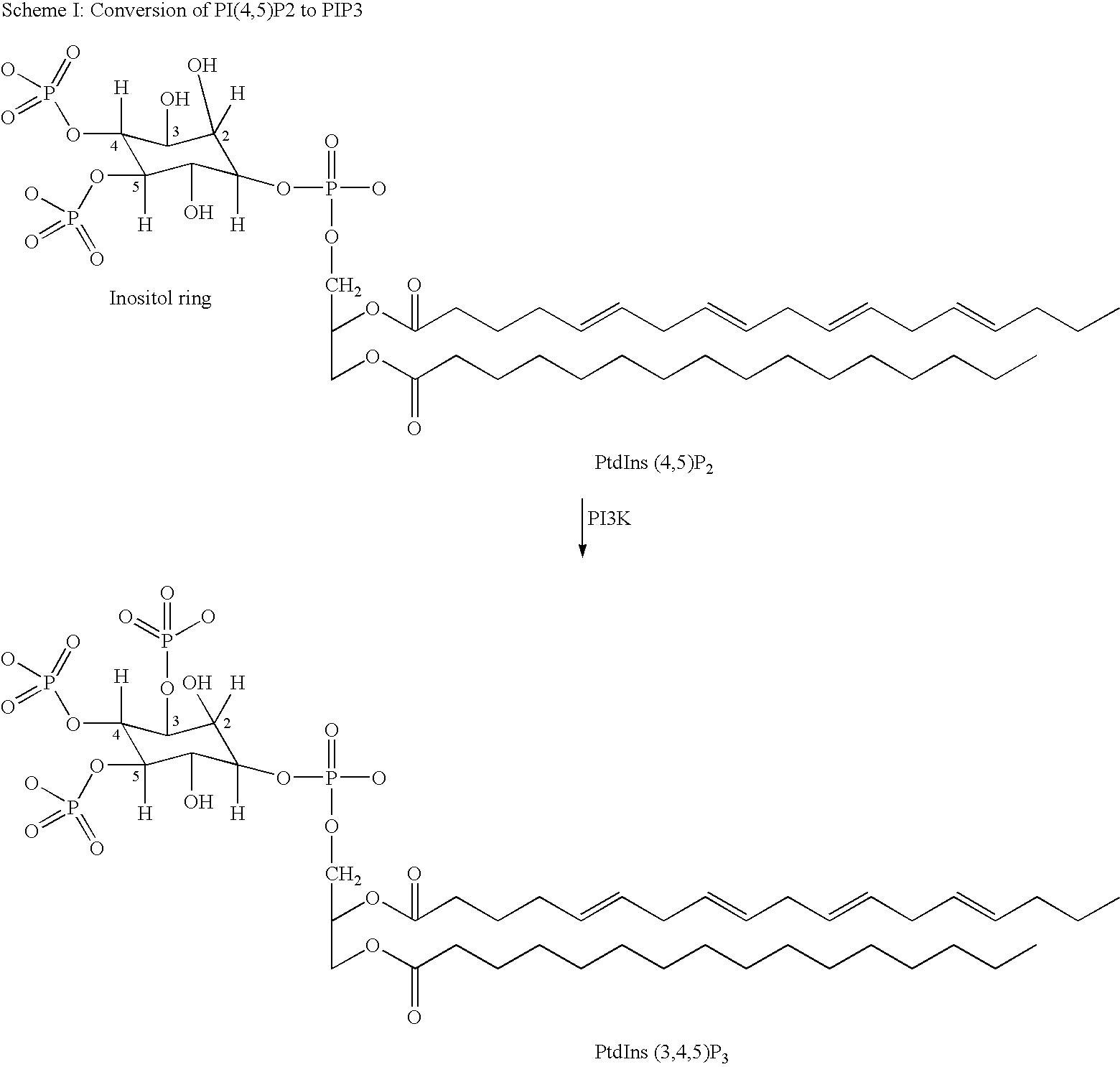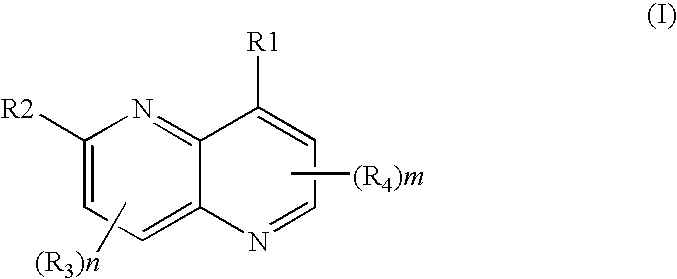Naphthyridine, derivatives as p13 kinase inhibitors
a technology of naphthyridine and derivatives, applied in the field of naphthyridine derivatives, can solve the problem of limited expression of the enzyme, and achieve the effect of reducing the risk of toxicity
- Summary
- Abstract
- Description
- Claims
- Application Information
AI Technical Summary
Benefits of technology
Problems solved by technology
Method used
Image
Examples
example 1
{5-[8-(4-pyridinyl)-1,5-naphthyridin-2-yl]-2-furanyl}methanol
[0261]
a) 2-(methyloxy)-8-(4-pyridinyl)-1,5-naphthyridine
[0262]A mixture of 6-(methyloxy)-1,5-naphthyridin-4-yl trifluoromethanesulfonate (16.2 mmol; see WO2006017326), 4-pyridinylboronic acid (19 5 mmol), and tetrakistriphenylphosphine palladium(0) (0.487 mmol) in saturated aq sodium bicarbonate (20.0 mL) and 1,4-dioxane (80.0 mL) was heated at 100° C. for 22 h. The reaction mixture was poured into saturated aq sodium bicarbonate (300 mL) and water (100 mL), and the organics were extracted with (4×300 mL) ethyl acetate. The combined organic layers were dried over sodium sulfate, filtered, and concentrated in vacuo. The residue was taken up in 1N aq hydrochloric acid (250 mL) and washed with (3×170 mL) dichloromethane. The aqueous layer was basified through careful addition of 6N aq sodium hydroxide (˜45 mL) until the product precipitated out of solution. The solid was filtered, rinsing with (3×50 mL) water, and dried in va...
example 2
2-amino-N,N-dimethyl-5-[8-(4-pyridinyl)-1,5-naphthyridin-2-yl]-3-pyridinesulfonamide
[0266]
a) 2-amino-5-bromo-3-pyridinesulfonyl chloride
[0267]To a cooled (0° C.) solution of chlorosulfonic acid (58 mL) under vigorous stirring was added 5-bromo-2-pyridinamine (86.7 mmol) portionwise. The reaction mixture was then heated at reflux for 3 hrs. Upon cooling to room temperature, the reaction mixture was poured over ice (˜100 g) with vigorous stirring. The resulting yellow precipitate was collected by suction filtration and washed with cold water and petroleum ether to provide the title compound as an orange-yellow solid (18.1 g, 77% yield). MS (ES)+m / e 272.8 [M+H]+.
b) 2-amino-5-bromo-N,N-dimethyl-3-pyridinesulfonamide
[0268]To a cold (0° C.) suspension of 2-amino-5-bromo-3-pyridinesulfonyl chloride (92.1 mmol) in dry 1,4-dioxane (92 mL) was added pyridine (101.3 mmol) followed by a 2M solution of dimethylamine in THF (101.3 mmol). The reaction was allowed to warm to rt for 2 h, heated to 5...
example 3
2-amino-5-[7-fluoro-8-(4-pyridinyl)-1,5-naphthyridin-2-yl]-N,N-dimethyl-3-pyridinesulfonamide
[0270]
a) 7-fluoro-2-(methyloxy)-8-(4-pyridinyl)-1,5-naphthyridine
[0271]A mixture of 8-bromo-7-fluoro-2-(methyloxy)-1,5-naphthyridine (1.95 mmol; see WO2006002047), 4-pyridinylboronic acid (2.33 mmol), dichloro[1,1′-bis(diphenylphosphino)ferrocene]palladium(II) dichloromethane adduct (0.058 mmol) in saturated aq sodium bicarbonate (3.0 mL) and 1,4-dioxane (12.0 mL) was heated at 100° C. for 17 h. Additional 4-pyridinylboronic acid (2.33 mmol) and tetrakistriphenylphosphine palladium(0) (0.058 mmol) was added and the reaction mixture was heated at 100° C. for 23 h. The reaction mixture was poured into saturated aq sodium bicarbonate (125 mL) and the organics were extracted with (3×100 mL) ethyl acetate. The combined organic layers were dried over sodium sulfate, filtered, and concentrated in vacuo. Purification of the residue by silica gel chromatography (30-60% ethyl acetate / hexanes) provided...
PUM
| Property | Measurement | Unit |
|---|---|---|
| volume | aaaaa | aaaaa |
| pH | aaaaa | aaaaa |
| time | aaaaa | aaaaa |
Abstract
Description
Claims
Application Information
 Login to View More
Login to View More - R&D
- Intellectual Property
- Life Sciences
- Materials
- Tech Scout
- Unparalleled Data Quality
- Higher Quality Content
- 60% Fewer Hallucinations
Browse by: Latest US Patents, China's latest patents, Technical Efficacy Thesaurus, Application Domain, Technology Topic, Popular Technical Reports.
© 2025 PatSnap. All rights reserved.Legal|Privacy policy|Modern Slavery Act Transparency Statement|Sitemap|About US| Contact US: help@patsnap.com



